Last week, online classes formally started in public schools. Despite the continued operations of the country’s academic sector, the Department of Education (DepED) reported that enrollment in all levels for the school year 2020-2021 dropped to over 25 percent from the previous year.
But parents working from home have found another option for their kids this school year—homeschooling, which Ella Martelino, mother of two, decided to try. “We have two children aged 8 and 6, and no house help. My husband has his own law practice and I have my own little company to manage on top of our household. Even during vacations, our days could get crazy. I’m not sure how we could handle hours of daily online classes for now.”
But for Ces Nitafan, also known on social media as Homeschool Momma PH, it’s business as usual since she’s been homeschooling her kids for a decade. “Before, people thought homeschool was only for the rich—children of diplomats, foreigners or celebrities. Or that it was for parents against traditional schools, or for child athletes or children with special needs.” But Ces believes that because of social media, parents have realized that homeschooling is not a status symbol, but a real option for their kids’ education. “Before, the Homeschoolers of the Philippines Facebook group only had 200 members. Now, we’re about 35,000!”
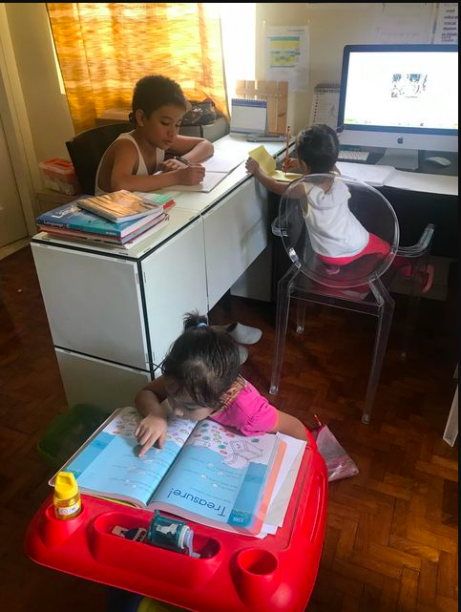 Ces’s three homeschooled kids
Ces’s three homeschooled kids
Journey to Homeschooling
The idea to homeschool her kids was cemented when she and her husband attended a Kids’ expo that featured a homeschool provider. When Ces saw how well the homeschooled kids were performing, she decided to take the plunge. “But here’s the clincher. To homeschool our child, someone had to stay home. At that time, my husband and I were both working, and I practically lived out of a suitcase. In fact, we were so busy that our child, who was 3 years old then, lived with my parents, and we only saw him on weekdays. “
The couple thought hard if their family could survive on a single salary. In the end, they decided to let go of their condo unit and let Ces resign. Her husband worked harder than ever while Ces stayed home to care for their son. “It turned out to be for the best,” she shares. “We couldn’t have a second child because my work was too stressful. When I quit my job, I had two more kids.”
Challenges of Homeschooling
Though homeschool seems ideal, Ces warns that it’s not a bed of roses. “When we started out, it was a constant warzone. My child had already attended school so when I began teaching him, he would go, ‘No, teacher is like this. Teacher is like that.’ And I’d reply, ‘No, I’m your teacher now!’”
Ces, like most mothers of her generation, grew up in a traditional school where students were taught to studiously copy notes and memorize. But since homeschool is closest to the progressive style of education, which is child-led, she had to unlearn a few things. “A decade ago, there weren’t a lot of homeschooling material on social media, so I had to read books on it. I even took up education units.” But Ces clarifies that homeschooling parents don’t have to go this far. “I strongly suggest talking to old-time homeschoolers because no book prepared me for this. Still, you have to understand that each family has its own dynamics. What worked for a successful homeschooling parent might not work for you. So just apply what you can, and as for the rest, be open-minded. There will be challenges, and you have to be flexible. It’s more on being intuitive.”
 Ces dividing her time between her two younger kids
Ces dividing her time between her two younger kids
Benefits of Being Your Child’s Teacher
Pre-pandemic, Ces enjoyed taking family vacations during the off-peak season. “We can even go to museums on weekdays when there are no crowds.”
By teaching her kids, Ces says she gets to know them on a much deeper level. “Homeschooling’s real gift to us is that we get to mold and witness the unfolding of each of our children’s unique character. When I see them interacting with other kids, I take pride that their self-esteem is well-placed, and that they’re not afraid to speak out. We them grow before our very own eyes.”
As to the financial cost of homeschooling, Ces debunks the idea that it’s pricey. “It depends on your diskarte. For the first two years, I had a homeschool provider that gave us everything we needed—books, a curriculum. We just had to submit grades, and that helped us a lot.” But when his son got bored with the books, Ces did her research and found another US-based provider that allowed them to customize the curriculum at one-fifth of the price. “We mixed and matched, and we paid about P25,000 for a school year. If you have a support group, you can share books so you don’t have to buy new ones. At that time, the bulk of our expenses went into enrichment classes—ballet, music, swimming.” But with today’s wealth of online resources, Ces says parents will have no problem honing their kids’ skills. “I know homeschoolers that save a lot of money because everything can be found online for free—even art and dance classes. There are even public-domain books you can download. You can be as frugal—and spend five to ten thousand pesos as year—or expensive as you like.”
Ces admits that homeschool books are costly because they’re shipped from the US. “But they’re expensive for a reason. They’re written in a way that you can use them from kinder to college. So your kids with different grade levels can use the same books.” But even this necessary cost can be whittled down. Aside from borrowing books, Ces saves on online subscriptions by splitting monthly fees and sharing usernames and passwords with other parents. “I want parents to know that you don’t have to spend a lot on homeschool. Whatever your economic status is, it’s doable.”
With homeschooling, Ella finds more freedom in educating her kids. “We get to decide on our kids’ learning pace. We could breeze through topics they’re interested in and spend more time in those they find challenging.”
Birth of Homeschool Momma PH
Ces used to have a blog, which she eventually migrated to Facebook. “It was established mainly to document our homeschooling for our provider. From a personal blog, the page evolved into a platform to encourage other homeschooling parents.”
When the pandemic hit, Ces saw her page likes balloon from 300 to 3,000. “. Some companies have approached me and I always tell them that instead of giving me something, they should give to the homeschool community. My vision for Homeschool Momma PH is for its group members to have benefits such as discounts or special access to education-related things.”
Because of the growing number of homeschoolers, Ces began the private group, the Better Together Support Group. “This was made for the new and accidental homeschoolers because of COVID-19. We do videoconferences to coach and mentor, and share resources.”
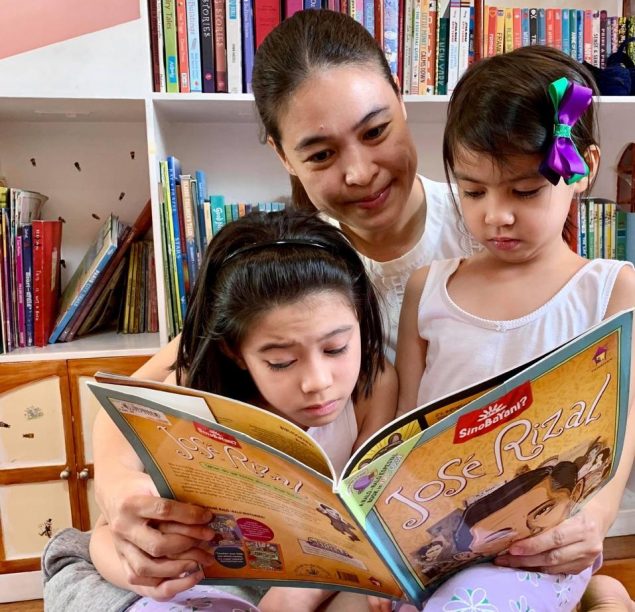 Ella reading to her daughters
Ella reading to her daughters
Homeschooling Tips for Newbies
Perhaps the greatest fear homeschooling parents have is that they’re incapable of teaching their children. Ella echoes this sentiment: “I’m still not sure if we’re doing things right, and if homeschool will work out for us in the long run.” However, Ces puts this fear to rest. “Really, you’ve been homeschooling your children ever since they were inside your tummy. You taught them to walk. We just delegated their education because we thought we couldn’t do it.” She gives these other tips:
Create a schedule— but be flexible.
Ces has an 8th grader, a 1st grader and a three year old. To manage a multi-level homeschool, she tries to allot 1 to 2 hours for each child. Her eldest, who prefers to study on his own, requires the least one-on-one time from her. “I’m more lenient with the younger ones, but I’m strict with my eldest to teach him time management skills.” To maximize time and effort, Ces gathers all her kids for character lessons. When it’s time for PE (Physical Education), she lets them choose the activity. “Sometimes they just go to the playground, and my eldest watches over the little ones, which, in itself, is a life skill. Now that our village has opened its swimming pool for one family at a time, we book it in advance so we can use it.”
Be relaxed, not lax.
“We advocate child-led learning. Some people are concerned about this, but we’ve seen kids who went through child-led learning and grew up to be productive and successful adults.” Ces also employs age-appropriate discipline. “When they’re younger, you allow them to explore and be relaxed. But when they’re moving on to middle school, to high school, then you introduce structure because you’re preparing them for college life.” For Ces, learning comes in many ways. “Try to make it fun for them. It doesn’t have to be pen and paper or books all the time. You can watch movies and then use that as your lesson for the day.”
Know your child’s learning style.
Is your child visual? Auditory? Kinesthetic?. “You can search this on the internet, and take the test to know your child’s learning style. Then you’ll know the best way to teach them—not based on how you were taught. Sometimes you catch yourself saying, ‘When I was your age, I already knew the multiplication table!’ It’s not like that. You have to adjust to your child.”
Make time for yourself.
Because teaching your children is no easy task, Ces stresses the importance of “me time.” “That’s a downside of homeschooling—you have less time for yourself. But my kids know that when 4 P.M. hits, I can’t be bothered. For an hour, at least, I have time to rest and relax.” Doing her morning prayers also equips Ces with the strength to get through the day. “I’ve tested and proven this all these years—when I wake up energetic, my kids are also lively and easier to teach. When I’m downcast, they feel the same. So it’s important to recharge.”
Unplug.
Though Ces runs a Facebook page, she doesn’t spend too much time on social media. “Because if you’re so immersed in social media—researching, joining groups, asking, reading all those posts—you’ll compare yourself and your kids with others. You will question and doubt yourself. It’s best to filter your resources.”
Don’t be too hard on yourself.
“Be forgiving,” advises Ces. “When schedules fail, when your plans fall through, go easy on yourself. If today, you didn’t solve that math problem, tomorrow, you can all be better. Allow for life to happen. Nurturing your relationship with your family is the most important.”
For more resources on homeschooling, check out Homeschool Momma PH on Facebook.
Last October 2, the Philippine Atmospheric, Geophysical and Astronomical Services Administration (PAGASA) released a La Niña Advisory, announcing the onset of above-normal rainfall conditions in the country.
According to the National Oceanic and Atmospheric Administration (NOAA), La Niña is a “cold event” that pertains to “below-average sea surface temperatures across the east-central Equatorial Pacific.” Analiza Solis, chief of PAGASA’s Climate Impact Monitoring and Prediction Section stated that the weak habagat (southwest monsoon) experienced from June to September this year was indicative of an impending La Niña. “Historically, below-normal rainfall conditions in areas under the Type 1 Climate (western parts of Luzon, Mindoro, Negros and Palawan) during the habagat season is a precursor or part of the early impacts of La Niña.”
Though “weak and moderate La Niña” is expected to persist until March 2021, PAGASA Administrator Dr. Vicente Malano warned to never underestimate its possible effects. “In 2006, Guinsaugon in Leyte experienced a massive landslide. It caused considerable damage in properties and deaths.” The disaster was believed to be triggered by an earthquake in Southern Leyte, and two weeks of non-stop rains induced by weak La Niña. The landslide buried around 980 of the village’s population of 1,857.
What to expect
The approaching amihan (northeast monsoon) is expected to enhance La Niña. Solis explained that the rainfall forecast for October this year until the first quarter of 2021 is 81 to 120% more than the normal. Areas most likely to be affected are MIMAROPA (Mindoro, Marinduque, Romblon, and Palawan), Visayas and Mindanao. Because of the 2006 landslide, PAGASA is also closely monitoring western Luzon, even if it is normally dry during La Niña. “Day-to-day forecasts are crucial, supported by tropical cyclone warnings and sub-seasonal forecasts, so we can prepare for possible extreme weather and rainfall events,” Solis said, adding that this La Niña, five to eight cyclones are expected until March 2021.
 (source: PAGASA)
(source: PAGASA)
Preparing for Possible Outcomes
According to Dr. Renato U. Solidum, Jr., the undersecretary for Disaster Risk Reduction and Climate, various agencies should focus on Disaster Risk Reduction Management (DRRM). “First, we need to monitor the different weather and climate phenomena, which PAGASA is doing. Second is assessing hazards and risks, which involves identifying the risks, their effects and the affected areas. Third is disseminating information and warnings to different sectors through proper communication channels. And fourth—the most important of all—is to have an effective and efficient response.” This includes mitigation measures, their effectivity, and a quick response that will lead to quick recovery.

Impact on Agriculture
Solis stated that during La Niña, low-lying agricultural lands are prone to floods, which may produce extensive crop damage. Recurring rains also increase the possibility of pests and crop disease, and may lead to river flooding and dam spillage.
Impact on Health
During excessive rainfall, there is a prevalence of waterborne diseases such as cholera and leptospirosis in flooded areas—things we need to avoid, along with loss of lives from flashfloods.
Impact on Environment
Landslides and mudslides are possible, while coastal communities are warned against coastal erosions due to strong waves. In the urban setting, damage to infrastructures is possible, as well as urban flooding, economic losses, and increased traffic.
 Angat Dam located in Bulacan (file photo)
Angat Dam located in Bulacan (file photo)
Filling our Dams
The water level in Angat Dam, which supplies 97% of Metro Manila’s water needs, has been slowly but continuously decreasing. “These past weeks, we’ve seen a decline in Angat, Pantabangan and other dams. Even if it rains in these areas, they don’t hit our reservoirs,” Dr. Malano reported. But because of the rainfall forecast during La Niña , our dams are expected to recover. Weather Services Chief Roy Badilla of PAGASA’s Hydrometeorology Division stressed this benefit of La Niña: “50% of our rainfall come from tropical cyclones and La Niña, so without the La Niña, our dams won’t have enough water.”
Solis encouraged the public to maximize rain water harvesting and storage to cope with the dry season from April to June. Flood warnings and advisories from PAGASA should also be monitored. To avoid floods, the Department of Public Works and Highways (DPWH) is requested to remove road obstructions. As local government units and disaster risk reduction offices prepare for imminent disasters, farmers need to strengthen their post-harvest facilities to ensure the proper drying and storage of their produce. “Adverse impacts are likely over the vulnerable areas and sectors of the country,” Solis added. “While our dams have their fill of rain, we should mitigate the possible impacts of La Niña and the amihan.”
La Niña and the Pandemic
Though La Niña is a natural climate variability, Solis said that climate change might also be affecting its pattern. “Before the year 2000, strong El Niño and La Niña episodes occur at least every 7 to 10 years. But during the past decades, the intervals have been cut down to 5 to 7 years. Along with their increased frequency is the increased intensity of their impacts.”
Because this year’s La Niña is coupled with the COVID-19 pandemic, PAGASA’s OIC-Deputy Administrator for Research and Development Esperanza Cayanan emphasized the need for preparedness in evacuation centers. “We need to enforce physical distancing among evacuees, and make sure that these centers are not used for COVID-19 patients.” Solis mentioned the same concern for hospitals. “Health care centers and hospitals should prepare for additional patients with water-borne diseases, and to separate them from COVID-19 patients.”
In the meantime, Dr. Malano suggested the use of schools and churches, now empty because of the prohibition of mass gatherings and face-to-face classes. “Disaster risk reduction should be everyone’s responsibility. We need to cooperate with each other so we can open up these facilities for evacuees, allowing them to observe physical distancing.”
For the past weeks, the water level in Angat Dam, which supplies 97% of Metro Manila’s water needs, has been slowly but continuously decreasing. According to the Climate Outlook Forum of the Philippine Atmospheric, Geophysical and Astronomical Services Administration (PAGASA) last September 23, the dam’s level was at 177.3 meters, 32.67 meters less than its normal water level of 210 meters.
But according to Rosalie Pagulayan of the Hydro-Meteorological Division of PAGASA, historical data in the past 14 years shows that Angat Dam’s water level typically dips during this time.
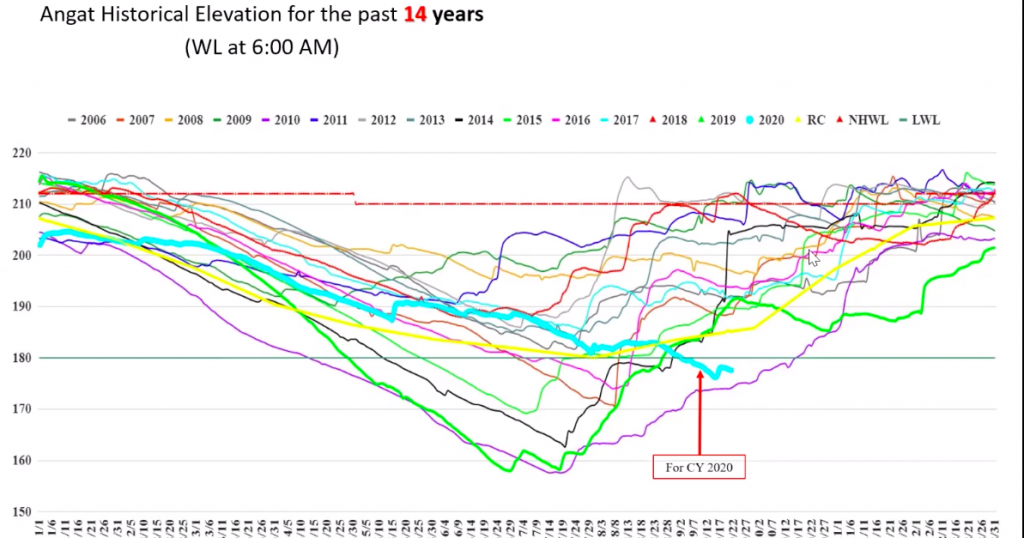 Angat Dam’s current downward trend in light blue (graph from PAGASA)
Angat Dam’s current downward trend in light blue (graph from PAGASA)
“Its level continues to decrease, but we expect it to increase during the Northeast Monsoon. Even with no typhoons, we can expect Angat Dam to recover in the last quarter of the year,” says Pagulayan. This is based on the forecast rainfall of PAGASA’s Climatology and Agrometeorology Division, which shows an expected 386 millimeters in October, 294 millimeters in November and 129.5 millimeters in December.
Forecast Rainfall for the remainder of 2020
| October | 386 millimeters |
| November | 295 millimeters |
| December | 129.5 millimeters |
Metro Manila’s Main Water Source
The Angat Reservoir and Dam is located in the Angat Watershed Forest Reserve in Norzagaray, Bulacan. According to Manila Water, the dam supplies the water requirements of Metro Manila, and irrigates about 31,000 hectares of farmlands in Pampanga and Bulacan. It also generates hydroelectric power for the Luzon Grid, and holds water to reduce flooding in downstream towns and villages.
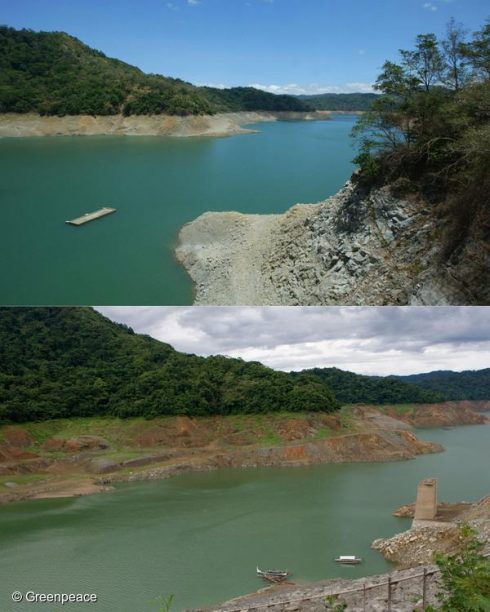 Top photo of Angat Dam taken last April 13, 2010 when water levels hit the critical 180 meters above sea level. Photo at the bottom with the structure completely exposed, was taken last July 16, 201, when levels reached a historical low of 157.55 meters. (Top photo by Joseph Agcaoili /Greenpeace. Bottom photo by Gigie Cruz-Sy /Greenpeace)
Top photo of Angat Dam taken last April 13, 2010 when water levels hit the critical 180 meters above sea level. Photo at the bottom with the structure completely exposed, was taken last July 16, 201, when levels reached a historical low of 157.55 meters. (Top photo by Joseph Agcaoili /Greenpeace. Bottom photo by Gigie Cruz-Sy /Greenpeace)
The dam usually stores enough water for Metro Manila’s 30-day supply. But El Niño, which refers to the unusual warming the oceans giving way to higher temperatures, can affect dam levels. On July 18, 2010, Angat Dam decreased to its all-time lowest level of 157.55 meters, the difference from its normal level roughly equivalent to the height of an 18-storey building. Because of El Niño, rain was below-normal, drying up the rivers that led to Angat Dam. Irrigation in Bulacan and Pampanga was cut to give way to the water needs of Metro Manila, which still experienced service interruptions. The government distributed relief goods among farmers and their families because they were unable to harvest.
Last year’s El Niño brought the Angat Dam down to 159.43 meters, just 2 meters more than its lowest record in 2010, prompting the National Water Resources Board to further reduce the allocation for Manila Water and Maynilad Water Services. Over 6 million residents of Metro Manila, Rizal and Cavite experienced daily rotational water interruptions from six hours to as much as 21 hours. Because of this, hospital operations and businesses were affected with some restaurants, carwashes and laundry shops closing temporarily.
 Residents waiting by the roadside for fire engines to fill up their water containers in 2019
Residents waiting by the roadside for fire engines to fill up their water containers in 2019
Why We and our Dams are in Danger
According to the World Population Review, Manila is now the most densely-populated city in the world with over 42,000 residents per square meter. Data from the Philippine Statistical Authority shows that over 21.3 million people live Metro Manila.
Overpopulation created a spike in water demand, especially during the sweltering El Niño season of 2019, one of the reasons a Manila Water representative pointed out as the cause of reduced water levels in dams. But the water crisis is a global one, which the Union of Concerned Scientists in the U.S. also attributes to climate change. Global warming alters the water cycle, affecting the “amount, distribution, timing and quality of available water.” While a warmer climate speeds up the evaporation of water on land and in oceans, it also holds more water that can be released through devastating typhoons, causing massive floods.
The Philippines’ water crisis also extends to limited access to water and sanitation outside the metropolis. The World Health Organization states that out of the 105 million living in the Philippines, around 7 million depend on water sources that are unsafe and unsustainable. In fact, one of the country’s leading causes of death in 2016 was acute diarrhea, causing over 139,000 fatalities.
An unreliable water supply severely affects public health, pushing people to look for other drinking water sources that may be unsafe. Basic hygiene—a must during this pandemic—is also compromised as one needs to thoroughly wash themselves, their clothes and their food to prevent infections from COVID-19 and other illnesses. When water pressure in pipes are low because of scarce supply, elements can contaminate the water once the pressure is restored.
Before Manila Water implemented rotational service interruptions in October last year, Metro Manila residents went on panic mode and stored water ahead of time. The move lowered water pressure, limiting its flow and distribution toward high places. WHO also cautions against the improper storing of water as this can allow mosquitoes to breed, possibly increasing the risk of diseases such as dengue fever.
Solving the Water Crisis
While individuals are responsible for their own health and safety by making sure their drinking water is safe and free from contamination, WHO states that the government also needs to provide long-term solutions. Groundwater and surface water from rivers and lakes will not last long when exacerbated by climate change and a growing population.
“Strategies such as the application of improved rainwater collection systems and state-of the-art desalination technologies coupled with renewable energies can be used in the Philippines,” says Environmental health technical officer in WHO Philippines Engineer Bonifacio Magtibay on the WHO website. “By adopting innovative and long-term solutions, the Philippines can ensure water for all that will protect the peoples’ health and help drive sustainable development forward.”
Pagulayan also reiterates that though PAGASA expects Angat Dam to recover, residents must not be complacent. “We have always called for the responsible use of water. This is a very important commodity because we use it for almost all our activities. Even if we’re not experiencing El Niño or other weather systems, we should always be looking at how we can maximize our resources. Let’s not waste water.”
For more tips on conserving water, watch this.
For more details on the Angat Dam, watch Panahon TV’s report.
One night, fifteen years ago, Lea was flipping through the channels on her television, looking for a movie to help her destress from her job as a financial adviser in one of the country’s top insurance companies. Instead, her channel surfing took her to a show on yoga, which kept her glued until the end. Watching the gentle flow of yoga poses helped relieve her stress, which kept her tuning in to the show regularly, until she found herself practicing yoga. “I fell in love with yoga since then. I loved how it had a holistic approach to health, focusing on both physical and mental abilities.”

For ten years, she dabbled with yoga until five years ago when she decided to make it her daily practice. “At that time, I was feeling exhausted and stressed. My body was pleading for a break. I decided to focus on myself.” With her regular yoga practice, Lea discovered a more focused way of thinking, and with this clarity came the realization of what she wanted to do with her life. “Two years ago, I decided to go to Vietnam to undergo training so I could be a yoga teacher. Our yoga class had five teachers, which we called masters. We would start our practice with pranayama, or breathing exercises coupled with meditation. It taught me to focus on my breath and to be still in the present. In the stillness, I could hear what my mind and body were telling me.”
Her six-month training certified Lea as a yoga teacher. Because of the pandemic, Lea holds online yoga classes, not just for Filipinos, but also for friends she made in Vietnam. At the same time, she supports her husband in developing an organic vegetable garden in Rizal. He focuses on growing high-nutrient fruits and vegetables that complement Leah’s yoga practice. Though Lea is living proof of yoga’s ability to help regulate blood pressure, fight insomnia and support the body’s natural healing process, she finds that the most important thing she gained from her practice is mental strengthening. “A weak mind can’t carry a strong body, but a strong mind can carry even the weakest body,” she shares. “A strong mind will keep you stable and grounded. It gives you the power to cope with stress.”
This October 14, Lea will share simple breathing and meditation exercises in Panahon TV’s much-awaited webinar, Peace of Mind during the Pandemic, which also features psychiatrist Dr. Rowalt Alibudbud, and Dr. RJ Naguit, chairman of the Youth for Mental Health Coalition, Inc.
From this webinar, Lea hopes that participants will learn to let go of things they can’t control. “Stress is inevitable, but what’s more important is that you know how to manage it. If you’re on a continuous fight-and-flight mode, you’ll get sick. Gentle yoga helps release the tension with mindful poses. Just by focusing on your breath, you honor your body, allowing acceptance, awareness and letting go. When you do this daily, you develop a calm state of mind. It’s a powerful tool to manage everything that’s happening in the world today.”
To register for the webinar, click here: https://panahon.tv/webinar/index.php
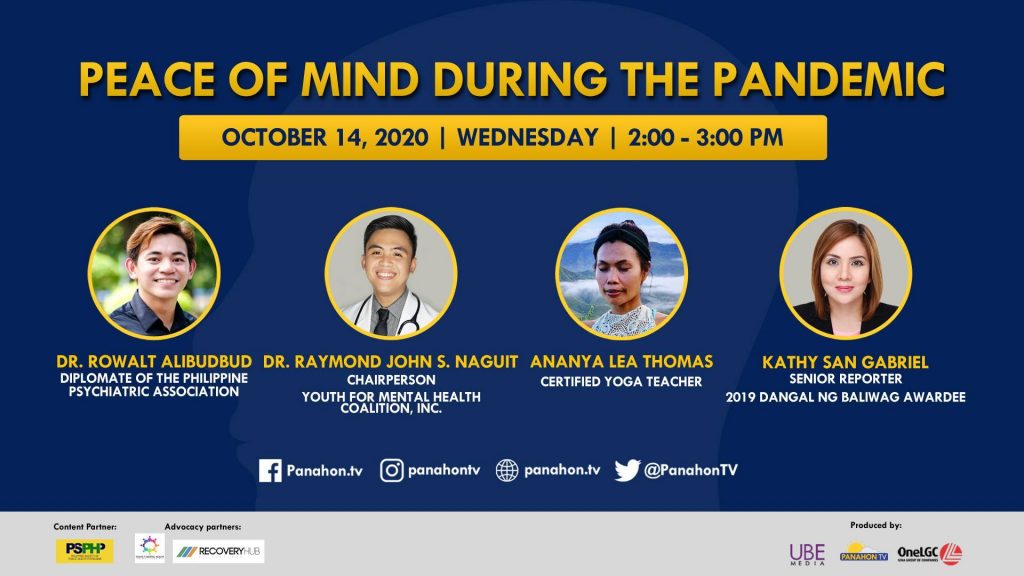
Last September 10, residents of California cities, particularly San Francisco, Oakland and Berkeley beheld an eerie sight of orange skies. Such was the result of wildfires raging in the US West Coast, their smoke and ash blotting out sunlight and creating the rust-colored haze.
According to the California Department of Forestry and Fire Protection, the wildfires began as early as January, and have already burned down more than 3 million acres in the state. Since the increased fire activity last August 15, there have been 24 deaths and over 4,000 damaged structures. But outside these figures, the wildfires have wreaked havoc in the atmosphere, putting areas under Air Quality Indexes of “very unhealthy” and even “hazardous”, forcing residents to stay indoors.
 Orange-tinged skies in the Bay Area in San Francisco last Sept. 10 at 10:30 a.m. (photo by Irma Cruz-Dimaisip)
Orange-tinged skies in the Bay Area in San Francisco last Sept. 10 at 10:30 a.m. (photo by Irma Cruz-Dimaisip)
The Pollution Problem
Even without the wildfires, ambient air pollution is a global problem, causing over 4 million deaths each year. According to the Centre for Research on Energy and Clean Air, pollutants are linked to severe respiratory and heart diseases, and lowers resistance against airborne viruses, making one vulnerable during the COVID-19 pandemic.
According to the World Health Organization (WHO), these human activities are the major sources of outdoor pollution:
- Fuel combustion from motor vehicles (e.g. cars and heavy duty vehicles)
- Heat and power generation (e.g. oil and coal power plants and boilers)
- Industrial facilities (e.g. manufacturing factories, mines, and oil refineries)
- Municipal and agricultural waste sites and waste incineration/burning
- Residential cooking, heating, and lighting with polluting fuels
- Poor urban planning, which leads to over-dependence on private vehicles
Combustion engines, fossil fuels and industrial activities produce Particulate Matter (PM), which contains sulphate, nitrates, ammonia, sodium chloride, black carbon, mineral dust and water. Most dangerous is PM2.5, which has a diameter of less than 2.5 micrometers. Because of its tiny size, PM2.5 is easily inhaled, allowing it to penetrate the lungs and blood stream, causing illnesses, which may lead to premature death.
WHO data further states that more than 80% of people living in urban areas that monitor air pollution are exposed to air quality levels that exceed WHO guideline limits. The most affected countries with the greatest toll are in the Western Pacific— and Southeast Asia, which includes the Philippines.
 Aerial view of the Pasig River (photo by Enrico Empainado/Greenpeace)
Aerial view of the Pasig River (photo by Enrico Empainado/Greenpeace)
Metro Manila’s Alarming Air Quality
Greenpeace Philippines reported a dramatic improvement in air quality during the enhanced community quarantine (ECQ) in Metro Manila from March 15 to May 15, 2020. With this measure to curtail the spread of COVID-19, most of the National Capital Region’s 2.5 million vehicles were kept off the road, resulting in PM2.5 levels dropping by an astounding 180%.
But this improvement was short-lived. Since the region shifted to general community quarantine (GCQ) last June 1, smog and pollution levels continue to climb, slowly reverting to the poor air quality experienced before ECQ.
Prior to the lockdown last February, groups such as Greenpeace, Clean Air Asia and the Center for Energy, Ecology and Development (CEED), Health Care without Harm, the Philippine Movement for Climate Justice (PMCJ), and the World Wildlife Fund for Nature (WWF) Philippines had called on the government to overhaul its monitoring and analysis of air pollution data to provide more accurate information. This was in response to the recent 2019 Air Visual report, which placed the Philippines in the 58th spot out of 98 countries. The groups argued that though the country’s ranking wasn’t high, data still showed that the country’s air quality was getting worse. In 2018, the country’s air pollution level of 17.6 micrograms per cubic meter was well beyond WHO’s safety limit of 10 micrograms per cubic meter.
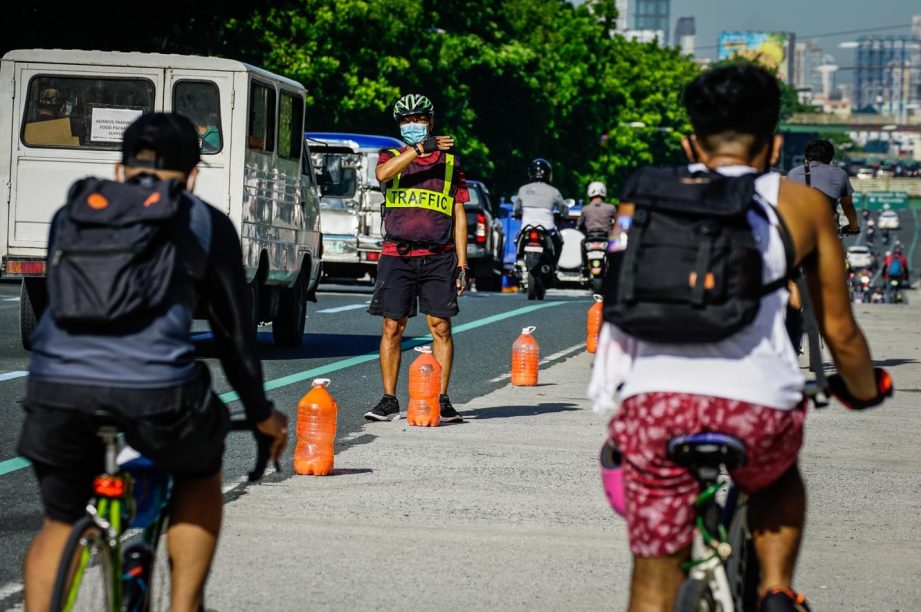 Bikers during ECQ (photo by Jire Carreon)
Bikers during ECQ (photo by Jire Carreon)
A Greenpeace Philippines report released in February, showed that toxic emissions could cost Filipinos as much as a 1.9% loss in Gross Domestic Product, as well as 27,000 premature deaths. For a clearer picture of the country’s air pollution, the groups urge the government to place monitoring stations near coal-driven power plants and areas of high traffic.
“The Philippine government should see the data as an impetus to overhaul air quality monitoring systems in the country, as well as to transition away from highly polluting facilities such as coal plants. Our safety standards for air pollution haven’t changed since 1999,” said Khevin Yu, campaigner of Greenpeace Philippines. “This situation has allowed industries and facilities to pollute the air we breathe with impunity.”
Meanwhile, Greenpeace campaigner Rhea Jane Pescador-Mallari believes that the ECQ showed Filipinos that healthy, clean air is possible in the metro. “Moving forward, if the government is willing to use the opportunities and lessons learned from the pandemic and amplify it through policies and infrastructure, active mobility and micro mobility, as well as invest in efficient and safe mass public transport, then a return to the massive pollution levels before COVID-19 can be avoided.”
Clean Air for All
The severity of recent global wildfires are fueled by climate change, which brings about soaring temperatures, drier conditions and pest outbreaks that weaken trees. According to WHO, air pollutants like black carbon and methane contribute to global warming and glacial melt. The Climate and Clean Air Coalition also states that air pollution threatens food and water supply by blocking sunlight, and affecting the movement and intensity of monsoons.
To secure the Filipinos’ health, Greenpeace Philippines advocates for the stricter implementation of the Clean Air Act, and the following measures:
- Maintaining flexible remote work arrangements or staggered work shifts, where possible
• People-centric urban design, where public spaces should be planned in parallel with the establishment of mobility programs
• Rebuilding trust in mass transit and supporting displaced transportation workers, possibly with LGU-centric green mobility services - Low-cost, active and carbon-neutral transport options that enable micro-mobility
• Tightening vehicle emission standards from Euro 2 to 4 to 6, and implementing accordingly
• Developing capabilities for real-time monitoring of dangerous pollutants in cities
• Strengthening industrial air pollution standards and wider adoption of renewable energy
Greenpeace believes that the efforts to solve air pollution are the same ones needed to mitigate the climate crisis. “As epicenters of growth, cities need to provide an environment that puts in high premium the health and wellness of both people and the planet. At the local level, addressing air pollution is a key aspect of making cities livable and sustainable. At the national level, it means addressing the climate crisis while helping build climate-resilient communities,” said Mallari.
Australia is currently on its second wave of Coronavirus Disease (COVID-19) infection. The first COVID-19 case in Australia was reported on January 25, 2020. The number of cases in the country sharply rose in March, then declined significantly in April due to lockdowns and strict health protocols. In July, Australia saw another increase in COVID-19 cases in Melbourne, the capital of the state of Victoria. Victoria is under lockdown as of writing. However, other states like New South Wales whose capital is Sydney, are under milder restrictions. Australia is the fifth country in the world with the largest number of overseas Filipino workers. Let us take a look at the day-to-day experiences of a Filipina living in Sydney on Buhay Pandemya.
While growing up, Filipino children get acquainted with animals such as giraffes, bears, rabbits and lions. But rarely do they know indigenous flora and fauna like the Philippine Eagle, tamaraw, musang and rafflesia. To bridge this gap, Anya Santos-Uy, who used to work at the Haribon Foundation, wrote and published an alphabet book, which highlights our local species. Watch the video to learn more about her children’s book.
“We are what we eat” is a popular statement that indicates how our diet affects our health. Recent studies, for instance, show that long-term consumption of red meat, particularly processed meat, increases risk of heart disease, colorectal cancer and type 2 diabetes. But with evidence of the food industry’s massive impact on the environment, it seems that our planet is also a reflection of what we choose to put on our plate.
According to Greenpeace, global meat and dairy production has become so intensive that it’s now a major cause of deforestation, and the degradation of oceans and freshwater sources. Since 1970, the planet’s wildlife has been cut down to half, while its livestock has tripled. If this issue is not addressed, the meat and dairy industry is projected to make up 70% of global greenhouse gas emissions in the coming decades.
 Crowded pig stall in Germany (photo by Greenpeace)
Crowded pig stall in Germany (photo by Greenpeace)
In an article, Pete Smith, Former Convening Lead Author for the Intergovernmental Panel on Climate Change (IPCC), stresses the need to reduce demand for livestock products. “Only a significant decrease in meat and milk consumption will allow us to deliver a food system fit for the future – for the benefit of humans and the planet as a whole. Producing the same mix of foods as we consume now, even if we were to do so more sustainably, cannot deliver the reduction in environmental impacts we need to protect the planet for our children and their children.”
Antibiotic resistance, which the World Health Organization declared as “one of the biggest threats to global health, food security, and development today”, is also linked to the livestock industry. Greenpeace reports that animals are subjected to overcrowded and unsanitary living quarters, overfeeding and over-administering of antibiotics to maximize profits. This inhumane treatment contributes, not only to antimicrobial resistance among meat consumers, but also food-borne illnesses.
To prevent environmental destruction, Greenpeace urges governments to gear toward more sustainable practices in agriculture. This includes lessening meat and dairy production, and focusing on growing cops to make plant-based foods more available.
Veganism = Environmentalism
 Mabi advocates a green lifestyle in the kitchen and beyond.
Mabi advocates a green lifestyle in the kitchen and beyond.
Veganism is generally perceived as referring to people who don’t eat animal products. But according to Mabi David, who describes herself as a plant-based cook, veganism is a way of life. “Veganism is an ethic, and diet is just one part of it. Veganism is a justice movement, and the issue of animal rights intersects with issues of human rights. Animal cruelty intersects with other prejudices like racism and sexism, in that they are different manifestations of an oppressive worldview where one group designates itself superior and entitled over another group that the former has defined as different, weaker.”

As a nutritionist and dietician, Gelo practices what he preaches.
Nutritionist and dietician Gelo Cruz was also inspired to turn vegan when he learned how cruel the meat and dairy industry was. “Animal cruelty extends to using animals for food, fashion and entertainment like in circuses and zoos. For me, these are all unnecessary forms of oppression to our fellow sentient beings.”
A vegan for two years, Gelo studied the negative health impacts of increasing meat consumption when he took up nutrition and dietetics in college. “But I was not aware that it was possible to live on a completely plant-based diet until I did further research as a professional,” he says.
Health was also a powerful motivation for Mabi to embrace veganism. “I’ve dabbled on and off in vegetarianism since I was in my early 20s, but thought I could not give up dairy products, such as cheese and yogurt which I was fond of despite my lactose intolerance,” she shares. In 2016, Mabi became vegan after reading an article that linked animal products to chronic diseases. “This was mind blowing for me. I realized I could actually live without cheese. I became vegan practically overnight.”
Health Benefits
As a nutritionist, Gelo believes in being preventive rather than curative, a mindset that prioritizes a healthy immune system over disease treatment. As to the argument that a vegan diet is nutritionally inadequate, Gelo says, “All the nutrients we need throughout human life stages can be acquired through a plant-based diet. There are a lot of plant-based protein sources such as beans, lentils, nuts, and seeds. Another great advantage of getting protein from plant-based sources is that it is packed with vitamins and minerals, which builds up the immune system, while protein sourced from animal-based food is packed with carcinogens and cholesterol.”
 Mabi shows off her fresh organic veggies
Mabi shows off her fresh organic veggies
For Mabi, veganism pushed her to cook her own food—a great way to manage one’s health. “I like the fact that whenever I feel like I am coming down with something, my immune system actually has a fighting chance against disease. Recovery time is quicker. In this time of global pandemic, we’re realizing how important health is.”
To ensure that her diet has minimal environmental impact, Mabi sources her organic vegetables from small-scale farmers, who typically grow food in their backyards. “Growing food so close to their homes, food that they will feed their families, these farmers make sure that their produce is not grown with chemical fertilizers and bombarded with toxic pesticides,” she says. “These small backyard farmers also grow a diverse set of produce to be able to feed their families with some variety, and diversity supports the health of multiple ecosystems that help protect our environment, from worms to bees to wildlife. Monocropping leads to the extinction of food crops that may be less popular but are vital to a culture, a community.”
Veganism as a Way of Life
 Gelo represented Vegan Strong Philippines, a support group for vegans, transitioning vegans and the vegan-curious, at the Spartan Race last October 2019. (Photo by Spartan Race Phils.)
Gelo represented Vegan Strong Philippines, a support group for vegans, transitioning vegans and the vegan-curious, at the Spartan Race last October 2019. (Photo by Spartan Race Phils.)
Aside from promoting the plant-based diet and vegan lifestyle, Gelo also volunteers in an animal shelter in San Pedro, Laguna. “We rescue stray cats and dogs, and animals scheduled for slaughter. We also conduct TNRs (trap, neuter, release/return) among stray cats to manage their population, and prevent their mistreatment and abuse.”
Mabi, who’s also a pet owner, likes the fact that no animal suffers with her lifestyle. “I am horrified that cows are kept impregnated all year round just so they can keep producing milk for humans, and that their babies are taken away from them right after birth so that they milk they lactate will be given to humans instead. I cannot imagine killing an animal that does not want to suffer and die simply because I like how meat tastes.”
 Mabi’s children’s book encourages children to be adventurous eaters.
Mabi’s children’s book encourages children to be adventurous eaters.
Complementing Mabi’s advocacy is her children’s book on eating the rainbow, a technique parents can use to make sure their children are getting enough nutrients from fruits and vegetables by making their plates as colorful as possible. “The book came about when I reached out to Greenpeace to propose a collaboration to help mainstream plant-based eating. The children’s book was Greenpeace’s idea, and we worked with Adarna House.”
Tips for Turning Vegan
Mabi believes that the local vegan scene is thriving, making it easier for meat eaters to make the transition. She and Gelo also offer these tips:
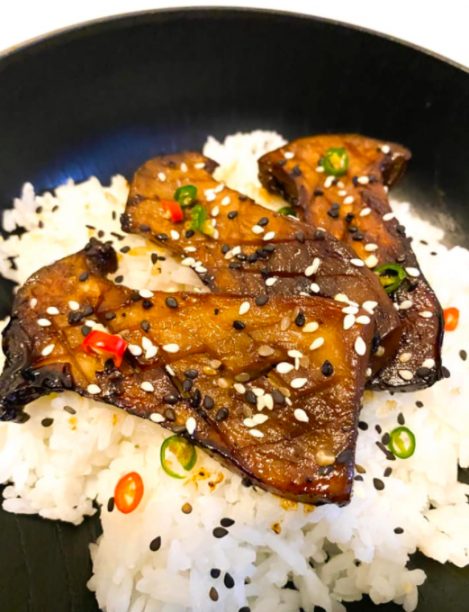 Spicy King Oyster Mushroom Teriyaki cooked by Misaki, Gelo’s girlfriend
Spicy King Oyster Mushroom Teriyaki cooked by Misaki, Gelo’s girlfriend
Consider vegan versions of your favorite food.
“I believe that there is an emotional attachment to food (e.g your mother cooking your favorite chicken noodle soup whenever you get sick), that’s why I recommend transition food like mock meat or veggie meat to satisfy cravings. These foods are not necessarily healthy, but they are healthier than animal meat.” At first, Gelo found it difficult to give up his favorite food—fried chicken. But he learned to trick his palate while staying vegan. “Whenever I crave fried chicken, I make it using cauliflower. It helped my palate adjust.”
Know why you want to make the change.
Are you switching to a plant-based diet because of health? is it because you refuse to be part of animal cruelty? Is it because of the environment? Gelo advises holding on to this purpose when meat cravings strike. “Whenever you feel tempted to go back to your old ways, remember why you’ve decided to go vegan.”
Do a pantry and kitchen reset.
“Start stocking up on healthier, plant-based ingredients,” says Mabi. “Out of sight, out of mouth.”
 Mabi’s probiotic-packed ensalada with lacto-fermented tomatoes and native corn
Mabi’s probiotic-packed ensalada with lacto-fermented tomatoes and native corn
Cut out processed foods.
Mabi believes these are designed to keep you craving for them, and desensitize your taste buds. “You’ll need to train your taste buds to detect delicate flavors and nuances,” she advises.
Make the journey enjoyable.
“If you feel deprived, it will be difficult,” says Mabi. Because she loves Indian food, Mabi loaded up on Indian spices and purchased an Indian cookbook to jumpstart her transition.
In the light of the pandemic, veganism, a practice on self-sufficiency, becomes even more relevant. “How do we feed everyone? How do we access healthy food to build our resistance? Whenever we eat, we are participating in the creation of a food system,” Mabi explains. “The farmer and the eater are interdependent, and we are not just consumers at the end of a long food chain. Rather, we are co-producers of the food system and we can shape it into one that is nourishing, just and sustainable.”
Know more about Gelo Cruz’s vegan advocacies on Facebook.
For Mabi’s vegan journey and recipes, check out Me and My Veg Mouth.

